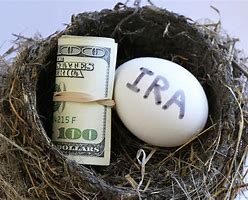We have talked about retirement vehicles: Traditional & Roth IRAs. Last week we talked about a garage they can be parked in: Employer-provided retirement plans. In this last part of three we talk about another garage: Self-employed plans. In self-employed plans, self-employed people (sole proprietorships and partnerships), small business owners, independent contractors and gig workers park their vehicles: SEP IRAs, and SIMPLE. We hope that you #SetItUp & #MaxItOut.
 REINFORCING THE BASICS
REINFORCING THE BASICS
What is a SEP IRA? Simplified Employee Pension. SEPs are traditional IRAs for self-employed or small business owners who set up individual accounts for themselves and their employees. Contributions are tax-deductible and grow tax-deferred until distributed. There are a couple of simple criteria for plan participation: a defined minimum compensation for the last two years; worked for the company any three of the last five years, and must be 21-years old.
What is a SIMPLE? Savings Incentive Match Plan for Employees. This vehicle is for small businesses with 100 employees at most and offering no other retirement savings vehicle. For employees to be eligible there must have been expected compensation of $5,000.
SEPs and SIMPLEs are in addition to Traditional and Roth IRAs.
HOW LONG HAVE THESE BEEN AROUND?
The SEP debuted in 1978. Remember, the 401K first appeared that year too. Disco was the rage and Elton John had no Billboard hits that year.
The SIMPLE’s first public appearance was 1997. Millennials were growing up. Elton John had the number one Billboard hit that year and the Spice Girls ruled the world.
HOW MUCH CAN BE CONTRIBUTED IN 2018?
SEP IRA. SEPs are not salary-deferred and there is no catch-up, meaning employees contribute $0 through work. Only the employer contributes, making this a profit-sharing plan. But keep in mind an employee may be able to make traditional contributions in 2018 of $5,500/$6,500 on their own to the SEP or open up their own IRA in addition to the SEP established on their behalf by their employer. If you are self-employed total contributions are limited to $55,000 in 2018.
Now, if you have a 401K and a SEP from your employer OR an employer 401K and a self-employed SEP #CallCarolFirst!
SIMPLE. The employee #MaxItOut amount is $12,500 plus the catch-up amount of $3,000. Like the SEP, if you want to save even more for retirement you can also open a separate Traditional or Roth IRA so #SetItUp & #MaxItOut. We’ll be sure to let you know the employee #MaxItOut 2019 amounts.
IS THERE AN INCOME LIMIT FOR CONTRIBUTING?
SEP IRAs. Employers can contribute 25% of employee compensation and 20% of self-employed net income up to a 2018 maximum of $55,000. Minimum compensation is $600 and maximum is $275,000 in 2018. We’ll be sure to let you know the 2019 amounts.
SIMPLE. The income limit is $275,000 in 2018 and we’ll be sure to update you with the 2019 amount.
HOW MUCH OF MY 2018 CONTRIBUTION IS TAX DEDUCTIBLE?
SEP IRAs. Remember employees cannot contribute to a SEP through salary deferral or pretax contributions.
SIMPLE. Employee contributions are salary reductions and therefore considered pre-tax and not technically tax-deductible.
HOW MUCH IS THAT MATCHING AMOUNT IN 2018?
SEP IRAs. No matching amount.
SIMPLE. The employer typically must match the salary reduction $ for $ up to 3% of entire calendar-year compensation, not limited by annual compensation of $275,000 in 2018 OR make non-elective contributions of 2% of employee compensation up to the annual compensation. These non-elective contributions MUST be given to ALL eligible employees whether they contribute or not.
CAN I CONTRIBUTE AFTER I RETIRE?
SEP IRAs. No. But as long as an employee is an eligible participant by meeting the criteria, the employer must keep contributing, even after 70 ½ and while the employee is taking RMDs.
SIMPLE. No.
WHEN CAN I GET MY MONEY?
SEPs & SIMPLEs. After age 59 ½: If you were hoping to hang onto it and leave it untouched for a while, you can. Until you are 70 ½. SEP AND SIMPLE IRAs are subject to RMD, the government makes you start taking your money out annually as a Required Minimum Distribution (RMD). You can take out more than the RMD but not less. And if you don’t take out the minimum, the punishment can be pretty hefty as that RMD amount not withdrawn is taxed at a whopping 50%. You have to take it out but you don’t have to spend it, you can put in into a Roth IRA or even a bank certificate of deposit. RMDs come into play with ALL pre-tax retirement accounts.
Just like being responsible for the accuracy of your tax returns, you are responsible for the accuracy of the RMD. There are folks who will help you though, namely the IRA custodian or plan administrator.
WHAT IF I NEED SOME CASH BEFORE I’M 59 1/2?
If you only need a few bucks for a month or two you can take it out of any of these plans but you MUST put it back in 60 days. And be sure to tell whomever to not withhold taxes or else that check could be 20% light. But if you have no intent to pay it back then the answer to this is mostly the same as last week too.
Sure, you can withdraw from the SEP & SIMPLE IRAs. Remember the withdrawn amount will increase your income and possibly put you in a higher tax bracket AND THEN there is the punishment. There are times when you can take your money out without being punished (the 10% penalty).
These are times of:
- Paying for health insurance premiums when unemployed for at least 12 consecutive weeks;
- Paying for medical expenses which total more than 7.5% of your adjusted gross income;
- Paying for college for yourself, your spouse, your kids, and even your grandkids;
- Disability as defined by the IRS and backed up by a doctor’s verification;
- Inheriting an IRA from your spouse and even folks you aren’t or were never married to;
- Buying, building, or rebuilding a house for the first time for yourself, your spouse, both sets of parents and grandparents and all the kids and grandkids BUT only up to $10,000;
- Serving your Country (Reserve and National Guard) for more than 179 days;
- Withdrawing on a specific schedule (SEPP – Substantially Equal Periodic Payments); and,
- Levying by the IRS themselves.
If you think you qualify for an exception #CallCarolFirst!
WHAT OTHER THINGS SHOULD I KNOW ABOUT SELF-EMPLOYED PLANS?
- There are time frames and deadlines in which these retirement accounts must be established. So, #CallCarolFirst!
- When compared to “qualified” employer-provided plans, qualified meaning complex and complicated, these plans are easier and cheaper to set up.
- You can rollover other retirement accounts into a SEP IRA. SIMPLE IRAs can be rolled over but not rolled into (except by another SIMPLE).
- With SIMPLEs there is no employed-on December 31st rule meaning employer contributes as long as employee is eligible whether they quit or kick the bucket.
- Also, with SIMPLEs if you withdraw before age 59 1/2 and within the first two years of the SIMPLE, the penalty is not 10% BUT 25%
There are exceptions to most rules and more than one way to cook an egg so if you are considering establishing a self-employed plan for yourself and/or employees, contributing or withdrawing funds, changing your contribution strategy, rolling over or transferring, converting or recharacterizing existing retirement accounts, or have recently inherited an IRA it is super important to reach out to McAtee and Associates for answers and guidance. #CallCarolFirst!
info@accpas.com OR 727-327-1999.
Be sure to check back here next week for some info on the TCJA and its effect on individual taxpayers. And like us on FaceBook and follow us on Twitter ; for whatever it is we’ll be posting. And remember # SetItUp! & #MaxItOut!


 REINFORCING THE BASICS!
REINFORCING THE BASICS!